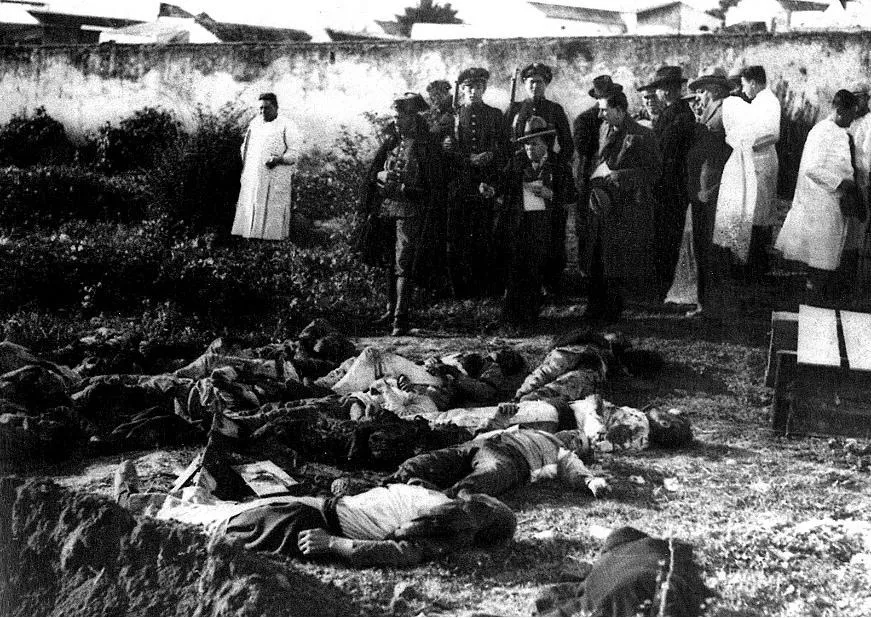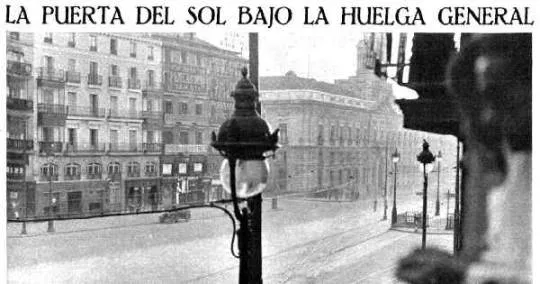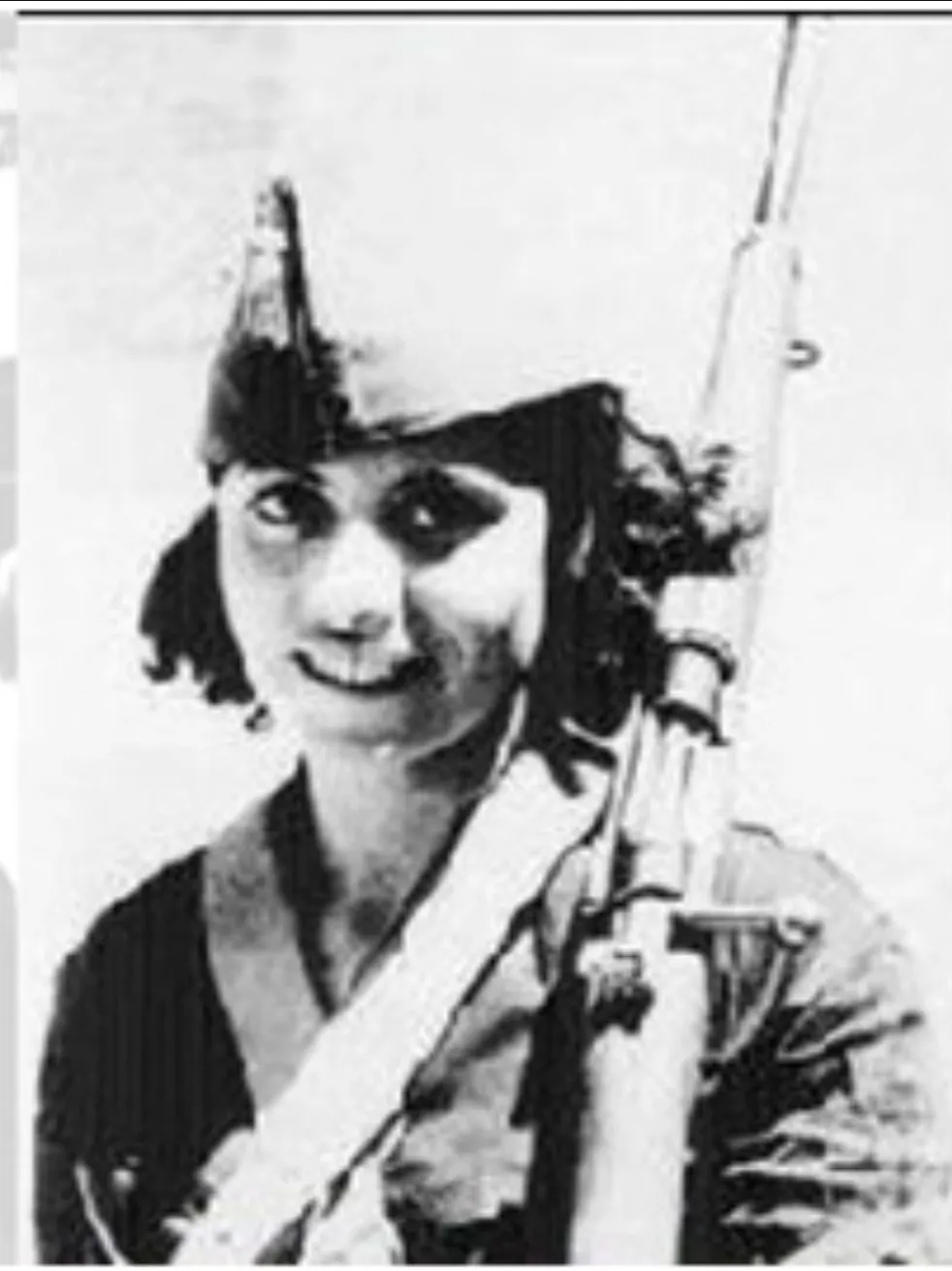The Second Spanish Republic is a figure in history which tends to be overly glorified by the contemporary Spanish left, including some excessively folklorist communists, as a desire to look through history for any instance when opposition to the monarchy and reactionaries was the hegemonic position. After 40 years of a fascist dictatorship, and 46 years of a liberal democracy that has exposed social-democracy's bankruptcy, the Second Republic is a time when the PCE (Communist Party of Spain) was a force to be reckoned with, at least compared to today, with a few hundred thousands along its lines. Despite the Second Republic lasting from 1931 to 1936, the aspects that tend to be glorified are the times of the Popular Front, the electoral alliance from the PSOE to the PCE that won the February 1936 elections, and ruled until the coup d'etat of July 1936. Perhaps unconsciously, perhaps consciously, the years of 1932-1935 tend to be not forgotten, but minimized.
This is because the Second Republic was not a "popular" state, it wasn't even nominally progressive for half its history. And again, in an exercise of willful ignorance, when its repressive episodes are discussed, most tend to focus on the Black Biennium, as historiography knows it, the two years (1933-1935) when the right governed under the CEDA coalition, which included falangists, monarchists, even Carlists. But the history of repression in the Second Republic begins not even a month after its constitution was ratified. The Castiblanco incidents of December 1931 saw a few day workers killed by the police during a peaceful demonstration asking for work, afterwards it turned violent and 4 policemen were lynched by the workers. That same week, in the Arnedo incidents, the 5th of January 1932, the police shot into a crowd of striking workers in the town's square, renamed recently to Republic Square. 11 people were killed, two of them a mother and his 4 year old son, another a 70 year old woman. 5 others were permanently left unable to work. Just a year later, in January of 1933, 19 men, 2 women and a child were massacred in the Casas Viejas Incident, after an attempted uprising and occupation of the police quarters.

The Second Republic was always an anti-worker state, from its very beginnings. Regardless of what its constitution said, the social advances of the republic were lubricated with worker's blood.
Let's set some context for the subject of this post: The PCE, section of the Third International, found itself at risk of disappearance at the end of the 1923-1930 dictatorship. It only really began to recover after José Diaz was elected General Secretary in 1932, it had about 1.000 members at this time, and by 1934 it had risen to 15.000 members, without counting the members of its youth wing. Internationally, the meteoric rise of fascism was unignorable. Nazi-fascism and fascism had seized power in Germany and Italy, and similar tendencies in Portugal and Austria were also in power, in the form of Salazar's Estado Novo in the former and Dollfuß' austrofascism in the latter, himself killed by outright nazi-fascists. Spain had its supposedly progressive Republic, of course, but it did not prevent the JONS to be founded in 1931 and the Falange in 1932, which during the civil war would merge into the infamous FE de las JONS, the Spanish Falange of the National-Syndicalist Offensive Juntas (The Falange is still a legal party now!). The leader of the CEDA, which would later govern during that Black Biennium I mentioned earlier, attended the Nürnberg Congress of 1932, where the pictures of those massive nazi-fascist rallies come from.
The 4th of October, 1934, 3 CEDA ministers had been chosen to enter the government, and in response, a strike, called the Revolutionary General Strike, was called for the following day, the 5th of October, 90 years ago today. The organization of this strike was done between the PCE, CNT (national confederation of workers, an anarcho-syndicalist union) and PSOE. The will to call the strike was not equal, however. The meeting minutes of the evening and night of the 4th show that the CNT was not very convinced of the strike and flip-flopped a lot, while the PSOE only decided to support the strike once it became impossible for them not to. The PCE, on the other hand, had already spent a few months warning of this, and preparing.
Barely a month before October, the police found a shipment of weapons going from the port of Gijón to Mieres, the future epicenter of the revolution. There were three armed shipments, and while the other two reached their destination, the third one being found almost lead to Indalecio Prieto, of the PSOE, being arrested. As a result, the weapon stashes in various places in Madrid (Casa del Pueblo, Ciudad Universitaria, Cuatro Caminos). These weapon stashes were supposed to supply the revolutionary strike in Madrid, and since they were found, the nascent revolutionary center was stillborn, since it was unable to arm itself. These same weapon stashes would later be replenished and used by the first militias of Madrid in the July 1936 coup d'etat.
Nevertheless, the call for a strike was distributed at 6:00 of the 5th, but it was only heeded in Asturias, Madrid, Vizcaya, Cataluña, plus a few weak points (Cantabria, Aragón, Alicante, León, Palencia, Málaga). The reason the call was not heeded in broader parts of the country was because the agricultural day workers, predominant throughout the central meseta and south had already carried out their own strike that same year. They were recovering, they feared the repression that was still fresh in their minds, and it did not help that the predominant political organization among them, the CNT, took too long to support the strike, they simply were not prepared. It is impossible to understate how crucial this point is. The greatest worker strata in Spain were unable to be reached by the call to a revolutionary strike, for reasons related to the situation, but because of the inability of the PCE of this time to truly penetrate the social majority.
At any rate, the Revolutionary General Strike was not ignored everywhere, from these days comes this picture of Madrid's very center devoid of people, withholding their work, but impotent to do anything more:

The Second Republic did not hesitate to stifle this strike, using planes and naval and land artillery. Once again, Spanish capital required trails of this country's reddest blood to line the streets, not shying away from employing the help of fascists such as the up-and-coming General Franco, sent to repress the workers of Asturias, where the strike was incandescent with revolutionary impetus. Before talking about Asturias, I won't ignore the other places where the strike was also popular. In Guipúzcoa and Vizcaya, The Basque Country, repression was just as bloody, executed by the Guardias de Asalto (Assault Guards), killing 40 workers in Vizcaya. There, the "Revolutionary Committee of Vizcaya", led by the UGT, was quickly dissolved. In Cataluña, a Catalan state was quickly declared, lead by the bourgeois Esquerra Republicana de Catalunya (Catalonian Republican Left), but was just as quickly put down with another 40 dead.
Asturias is another story, one that lasted for two weeks. It isn't much, but in those two weeks, the Spanish proletariat came the closest to holding political power, closer than any other time in its history. There, the strike did have a pre-existing entity capable of organizing the strike: the Worker and Peasant Alliance formed the 1st of April of that year, an armed force influenced by UGT, CNT (only present in the Asturias alliance), the Asturian Socialist Federation, and the PCE, whose militants often represented the most advanced elements of these alliances, but simultaneously relatively few. These alliances were heavily inspired by the Soviets, and often talked about the Sovietization of industry and of opposing colonialism. While this is evidence that it really was an attempted revolution, and that they were inspired by the Bolshevik revolution, their attempt to imitate the USSR's Soviets instead of learning from them was one of the many factors that provoked its defeat. Despite the name, the Worker and Peasant alliances were never as strong among peasants, not a lot of effort was put into it.
Another organization that was relevant during the October Revolutionary Strike were the Workers and Peasant's Antifascist Militias (MAOC in Spanish), a paramilitary militia, founded by Antonio Modesto, a member of the PCE educated in the USSR, he'd later become famous within the republican side of the Civil war. These militias were few but competent, they counted 150 members in Madrid and Asturias each, and while the Asturias militias participated in the revolution, the ones in Madrid sabotaged the roads and railways leading north, to avoid reinforcements getting to Asturias. These militias would later be the base from which the Fifth Regiment was created, in July 1936, to commence the defense of Madrid from the coup d'etat and fascist assault.
In Asturias itself, the proletariat lunged forwards as fast as it could, growing from the town of Mieres and the Nalón basin, to every other mining basin, taking the cities of Oviedo and Gijón by force. The National Guard's many stations were occupied and raided for arms and ammunition, they already had access to explosives from mining equipment. At one point, they felt strong enough to consider a march on Madrid, and even proclaimed the Asturian Socialist Republic. In what sometimes was called the Asturian Commune, a reference to the Paris Commune of 1871, production was controlled by workers, protected by a combatant force of up to 30.000 strong. Production in the metallurgical and mining industry was organized through attempts at imitation of the Soviets, as I mentioned. The Asturias branch of the Central Bank of Spain was expropriated as well, substituting money for a system based on coupon-like vouchers. However, the Revolutionary Committee leading the revolution was dissolved and reformed 2 times in those weeks, without counting the third dissolution that came with capitulation, although that committee did begin to plan the region's economy, the short span of time not really being enough to judge its efficiency.
The revolutionaries' retreat only began once the Republican government, as anti-worker as ever, followed the advice of generals Franco and Godet to deploy the Tercios de Regulares and the African Legion, two battle-hardened groups of the military not afraid to be brutal against the workers. While they advanced, for instance, they executed every wounded solider or civilian found in captured hospitals. In Asturias, more than a thousand workers were killed in combat or executed, and in total throughout Spain, the strike concluded with 2.000 dead, 7.000 wounded, and 40.000 imprisoned, for the crime and sin of daring to govern oneself and to end the exploitation of man by man. One of these dead workers stands out among the rest in popular culture nowadays, a member of the PCE's youth wing: Aida de la Fuente. She was only 19 when she joined the revolution in motion, the daughter of the PCE's founder in Oviedo, and she was known to be an exceptionally brave and dedicated communist. The 13th of October, a few hours after being seen distributing leaflets to civilians urging them to join the revolution, she found herself almost alone in Oviedo, trying to hold off the Legion's advance by manning a machine gun, and she managed to do so for a few hours. She was reached nevertheless and when a Legion commander asked her to surrender, she only responded by shooting back. Seconds later she was killed, and later found in a common grave. The counter-revolutionary press attempted to paint her murder as one committed by her own comrades, even claiming rape, but this was disproved by a journalist who risked his own life, and the testimony of the very legionary who executed Asturias' reddest rose.

The Asturias revolution was, for all its merits and promise, a stillborn revolution. The Communist Party did not have effective direction over the mass of proletarians involved in the revolution, let alone the even greater mass who, for one reason or another, did not meet the conditions necessary for attempting to seize power. The strike's organization was insufficient and thwarted in part, and militarily, the objective Indalecio Prieto was tasked with of securing support among the military officials, along with the general inferiority of the Asturian revolutionaries compared with the elite bodies of the military, meant there was no realistic chance of success. The strike was not even fully effective within Asturias, for instance, the livestock peasants known as vaqueiros, of the southwest, did not ever really have their influence. The PSOE militants who did exist in the region got into trucks and left for Oviedo, while a column of revolutionaries from León, the other side of the mountain range, tried to take Cangas del Narcea, the main town of the region, but they were routed by the National Guard.
After the defeat, 121 revolutionaries exiled themselves to the USSR, mostly communists but also accompanied by a handful of anarchists. There, they received education as cadres, who later returned to Spain before and during the civil war, providing invaluable expertise. Others chose to exile in Portugal or France, but both those countries repatriated them to be imprisoned in Spain.
During the negotiations between the Popular Front and the PCE for the 1936 elections, the main requisite they demanded in order to join was the amnisty of these tens of thousands of imprisoned workers, from the October Revolution and from the myriad of episodes of repression during the Black Biennium. To achieve this amnisty, they were also helped by International Red Aid, a political Red Cross founded by the International in 1922. They, along with the PCE, also provided a pension for the families of the many imprisoned. During the civil war, the Red Aid played an important role in the republican side's medical centers.
This episode is often forgotten when talking about the civil war, but it was one of the many reasons fascists were allowed to take power. Spain's risk of sovietization was an internationally recognized risk, so when the opportunity came, Spanish, English, French, and US capital very gladly did everything they could to hamper the Republic.
The lesson from the October Revolution of 1934 is clear. Without country-wide preparation, without a proper analysis of your own conditions, and without achieving social alliances, any revolutionary struggle is bound to fail. The lack of support in the much greater agricultural areas, the rushed planning and failed planning everywhere but Asturias, partially, the PCE's still weak influence in most organizations or regions, all of this meant that, whatever the Spanish proletariat learnt in that Revolutionary General Strike, was bound to be written in sweat and blood. The point of commemorating this bittersweet memory is not to dwell on what could have been, nor to recreate the MAOCs. It's to remember that a revolution is always a couple of bad decades away, and that not building consciousness and preparing structures for it will only mean more unnecessarily murdered workers. It's to ensure that, next time red October is around the corner, it will not be premature. The strength of the working class, our class, the social majority, lies not in the number of victories and defeats, but in the very fact of our fight, explicit and implicit. It lies in the fact that, for as long as classes based on exploitation exist, class conflict is unavoidable.
Many political forces nowadays, which one might call opportunist, will try to draw parallels between that autumn of 1934 and today, exhorting "unity of the left". The only unity that's truly revolutionary, the only unity that will not cause the subordination of our class interests to electoral or immediatist growth objectives, is the unity of the entire working class under a single Communist Party. The PSOE, even with its very involved marxist wing, characterized by the likes of Largo Caballero or Indalecio Prieto, only ever conceived of the Revolutionary General Strike as a means to the end of preventing those CEDA ministers from being appointed and in turn, gain more electoral and institutional strength. They also happened to be a relevant force because of their sheer number of members.